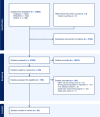Cone beam CT in the imaging of musculoskeletal trauma: a scoping review
- PMID: 40369229
- PMCID: PMC12361264
- DOI: 10.1007/s00256-025-04947-w
Cone beam CT in the imaging of musculoskeletal trauma: a scoping review
Abstract
Introduction: Cone beam computed tomography (CBCT) is an emerging technology in musculoskeletal (MSK) imaging. The objective of this scoping review was to provide an overview of the research surrounding CBCT utility in bony injury assessment as an alternative to other imaging modalities and investigate any gaps in the current evidence base.
Methods: MEDLINE, CINAHL, and PubMed were searched up to January 2025 for articles including CBCT studies on human participants following trauma. An online literature review tool was used to manage and streamline the review process.
Results: The search yielded 23 studies. The image quality and diagnostic accuracy of CBCT were high overall, and a number of studies confirmed the radiation dose to be lower than multislice CT. Studies examined CBCT for extremity trauma, with half the studies focused solely on the wrist. The utility appears greatest in the identification of radiographically occult fractures. Limited cost-effectiveness analysis has been undertaken.
Conclusions: Overall, the literature suggests CBCT can be an effective tool in the diagnosis of bony injuries with greater sensitivity than radiography at a lower radiation dose than multi-slice computed tomography. However, evaluation of wider patient and economic impacts of adopting CBCT in MSK trauma pathways is recommended.
Keywords: Cone beam computed tomography; Imaging; Musculoskeletal; Occult fracture; Trauma.
© 2025. The Author(s).
Conflict of interest statement
Declarations. Ethics approval and consent to participate: Not applicable. Conflict of interest: The Mid Yorkshire Teaching NHS Trust has a research agreement with FujiFilm Healthcare Ltd. for the evaluation of a CBCT scanner. No financial relationships exist with the authors. No other conflicts of interest exist.
Figures
Similar articles
-
Prescription of Controlled Substances: Benefits and Risks.2025 Jul 6. In: StatPearls [Internet]. Treasure Island (FL): StatPearls Publishing; 2025 Jan–. 2025 Jul 6. In: StatPearls [Internet]. Treasure Island (FL): StatPearls Publishing; 2025 Jan–. PMID: 30726003 Free Books & Documents.
-
Elbow Fractures Overview.2025 Jul 7. In: StatPearls [Internet]. Treasure Island (FL): StatPearls Publishing; 2025 Jan–. 2025 Jul 7. In: StatPearls [Internet]. Treasure Island (FL): StatPearls Publishing; 2025 Jan–. PMID: 28723005 Free Books & Documents.
-
A systematic review comparing the effective radiation dose of musculoskeletal cone beam computed tomography to other diagnostic imaging modalities.Eur J Radiol. 2024 Aug;177:111558. doi: 10.1016/j.ejrad.2024.111558. Epub 2024 Jun 10. Eur J Radiol. 2024. PMID: 38964225
-
Contrast-enhanced ultrasound using SonoVue® (sulphur hexafluoride microbubbles) compared with contrast-enhanced computed tomography and contrast-enhanced magnetic resonance imaging for the characterisation of focal liver lesions and detection of liver metastases: a systematic review and cost-effectiveness analysis.Health Technol Assess. 2013 Apr;17(16):1-243. doi: 10.3310/hta17160. Health Technol Assess. 2013. PMID: 23611316 Free PMC article.
-
The use of cone-beam computed tomography (CBCT) in radiocarpal fractures: a diagnostic test accuracy meta-analysis.Skeletal Radiol. 2022 May;51(5):923-934. doi: 10.1007/s00256-021-03883-9. Epub 2021 Sep 20. Skeletal Radiol. 2022. PMID: 34542681 Free PMC article.
References
-
- Vallier HA, Ahmadinia K, Forde FA, Ekstein C, Nash CL, Tornetta P. Trends in musculoskeletal imaging in trauma patients: how has our practice changed over time? J Orthop Trauma. 2014;28:e236–41. 10.1097/BOT.0000000000000076. - PubMed
-
- Doan MK, Long JR, Verhey E, Wyse A, Patel K, Flug JA. Cone beam CT of the extremities in clinical practice. Radiographics. 2024;44: e230143. 10.1148/rg.230143. - PubMed
-
- Grassi R, Guerra E, Berrito D. Bone fractures difficult to recognise in emergency: may be cone beam computed tomography (CBCT) the solution? Radiol Med. 2023;128:1–5. 10.1007/s11547-022-01584-4. - PubMed
-
- Weber MT, Stratz N, Fleiner J, Sculze D, Hannig C. Possibilities and limits of imaging endodontic structures with CBCT. Swiss Dent J. 2015;125:293–311. 10.61872/sdj-2015-03-150. - PubMed
-
- Tschauner S, Marterer R, Nagy E, Singer G, Riccabona M, Soratin E. Experiences with image quality and radiation dose of cone beam computed tomography (CBCT) and multidetector computed tomography (MDCT) in pediatric extremity trauma. Skeletal Radiol. 2020;49:1939–49. 10.1007/s00256-020-03506-9. - PMC - PubMed
Publication types
Grants and funding
LinkOut - more resources
Full Text Sources


